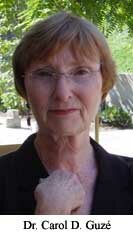BIO 590 MENU
syllabus 
schedule 
Biology 590 - Graduate Seminar
Spring 2004
"Why The Y"
|
Instructor: |
Carol D. Guzé, Professor of Biology and Ph.D. Medical Geneticist, ABMG |
|
|
Office: |
||
|
Telephone: |
||
|
Lecture Room |
NSM B 122 |
|
|
E-mail: |
||
|
Office Hours: |
Mon 1:30-5:30 |
|
|
Web site: |
||
|
Course Prerequisites : |
Graduate standing and completion of the following courses: |
Bio 590 Class Spring 2004

Recommended Preparation
Background for the seminar can be found in an interesting well illustrated genetics reference text: Color Atlas of Genetics by Eberhard Passarge, 1995, and another excellent textbook, Thompson and Thompson, Genetics in Medicine, 6th edition by Nussbaum, McInnes, and Willard. In addition, your cell and molecular biology, biochemistry, genetics, and human genetic texts will have background material and the molecular genetic techniques used. There is also much to be found on the internet.
Objectives & Learning Outcomes
- Understanding the structure of the Y chromosome, its origin, and gene content
- Researching the literature assigned regarding the Y chromosome
- Presenting the information from an assigned journal article(s)
- Demonstrating understanding of all papers presented by asking questions
Evaluation of Presentations
Your grade will include the evaluation of the presentations based on:
- Adequate consultation with the instructor and preparation (including handouts to classmates ahead of time.
- Command of subject (ability to talk without reading)
-
Speaking voice: volume and enunciation (clarity of delivery)
- Posture and appearance (professional appearance, erect, facing audience when speaking)
- Correct pronunciation and explanation of unusual words (could you understand all the words used?)
- Eye contact (looking at audience, not at your notes, the screen or off into space)
- Quality and effectiveness of Power Point or other presentation materials including visuals (did they help in understanding, were they attractiave, was it adequate to clarify the major points, were they too cluttered?)
- Well thought out beginning (e.g., title of talk, authors, sources), middle (body of talk, major points) and conclusion (summary of points covered and not abrupt); was the talk well organized
- Ability to convery subject matter clearly and simply (did the class understand everything and learn something?)
- Logical and easy to follow outline and objectives
- Ability to answer questions (or to say, "I don't know.")
- Involvement of audience (was there an attempt to involve the audience, did the class feel free to ask for clarification, did the audience appear interested and attentive?)
- Delivery fit allotted time (not too short, not too long)
In addition, your grade will include an evaluation of your attendance and participation in the class meetings (questions asked, knowledge of the subject presented, etc.) and your score on the final examination which will be on the material in the presentations.
Academic Integrity
It is essential that you read those pages in the University Catalog explaining Academic Integrity: Its Place in the University Community. It explains academic integrity and the nature of academic dishonesty. It also describes the role of the faculty and student in promoting academic integrity. In addition it explains the University policies and procedures for dealing with questions of academic dishonesty.
How to read journal articles
To evaluate the literature, write out for the entire journal paper and figures:
1. Which big question/hypothesis did the paper address?
2. What is the author's hypothesis for the big question?
3. What were the general conclusions?
4. For each figure:
A. What is the biological question addressed by this experiment?
B. How is it related to the general hypothesis?
C. What type of experimental procedure/protocol was used to answer this question? Is it a good method? What are the drawbacks of this method? at this phase use textbooks, protocols and dictionaries to learn about methods/results.
D. What is the readout of this type of experiment?
5. How is the readout/result interpreted? do you agree? why? why not?
6. What future work should be done with project?
7. Write a summary of your presentation in two pages or less.Look at the "Links" on Bio 442 web page.
More links:
Y-Chromosome (26-STR) DNA Test (interesting site for tracing Y chromosomes in pedigrees)

